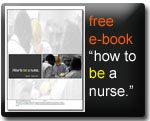New AACN Statistics Show an Increase in Nursing Enrollment
The American Association of Colleges of Nursing (AACN) has released new data which shows an enrollment surge in Baccalaureate and Graduate Programs. In fact more than 75,000 qualified applications to professional nursing programs were turned away in 2011. Despite the fact that US nursing schools have been able to expand student capacity even in the face of faculty and resource shortfalls, "the latest data show that 75,587 qualified applications to professional nursing programs were turned away last year, including more than 14,354 applications to graduate programs." Click on the link for the full report on the AACN website.
Monday, March 26, 2012
Evidence-based Practice Among Swedish Novice Nurses
Evidence-based Practice Among Novice Nurses
"A modest start, but a steady rise in research use: a longitudinal study of nurses during the first five years in professional life." by Lars Wallin, Petter Gustavsson, Anna Ehrenberg and Ann Rudman
Implementation Science 2012, 7:19 doi:10.1186/1748-5908-7-19, Published: 19 March 2012.
Rationale for the study: "Newly graduated nurses are faced with a challenging work environment that may impede their ability to provide evidence-based practice. However, little is known about the trajectory of registered nurses' use of research during the first years of professional life. Thus, the aim of the current study was to prospectively examine the extent of nurses' use of research during the first five years after undergraduate education and specifically assess changes over time."
Conclusion: "There was a clear trend of increasing research use by nurses during their first five years of practice. The level of the initial ratings also indicated the level of research use in subsequent years. However, it took more than two years of professional development before this increase 'kicked in.' These findings support previous research claiming that newly graduated nurses go through a 'transition shock,' reducing their ability to use research findings in clinical work."
The title link takes you to the open source article published online in Implementation Science .
"A modest start, but a steady rise in research use: a longitudinal study of nurses during the first five years in professional life." by Lars Wallin, Petter Gustavsson, Anna Ehrenberg and Ann Rudman
Implementation Science 2012, 7:19 doi:10.1186/1748-5908-7-19, Published: 19 March 2012.
Rationale for the study: "Newly graduated nurses are faced with a challenging work environment that may impede their ability to provide evidence-based practice. However, little is known about the trajectory of registered nurses' use of research during the first years of professional life. Thus, the aim of the current study was to prospectively examine the extent of nurses' use of research during the first five years after undergraduate education and specifically assess changes over time."
Conclusion: "There was a clear trend of increasing research use by nurses during their first five years of practice. The level of the initial ratings also indicated the level of research use in subsequent years. However, it took more than two years of professional development before this increase 'kicked in.' These findings support previous research claiming that newly graduated nurses go through a 'transition shock,' reducing their ability to use research findings in clinical work."
The title link takes you to the open source article published online in Implementation Science .
Friday, March 23, 2012
RN's Supply & Demand
NEJM: Perspective
"Registered Nurse Labor Supply and the Recession — Are We in a Bubble?"
by Douglas O. Staiger, Ph.D., David I. Auerbach, Ph.D., and Peter I. Buerhaus, Ph.D., R.N.
March 21, 2012.
NEJM article provides an economic explanation of the "countercyclical nature of the health care industry", based on a workforce study model analysis of trends in RN labour force supply and demand.
"Registered Nurse Labor Supply and the Recession — Are We in a Bubble?"
by Douglas O. Staiger, Ph.D., David I. Auerbach, Ph.D., and Peter I. Buerhaus, Ph.D., R.N.
March 21, 2012.
NEJM article provides an economic explanation of the "countercyclical nature of the health care industry", based on a workforce study model analysis of trends in RN labour force supply and demand.
Subscribe to:
Comments (Atom)








